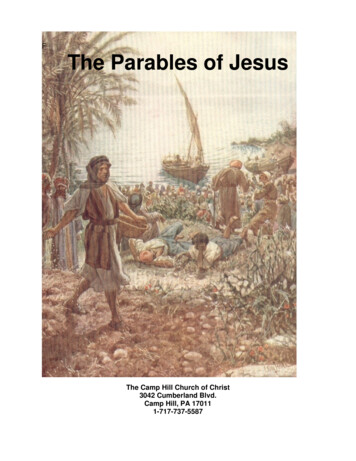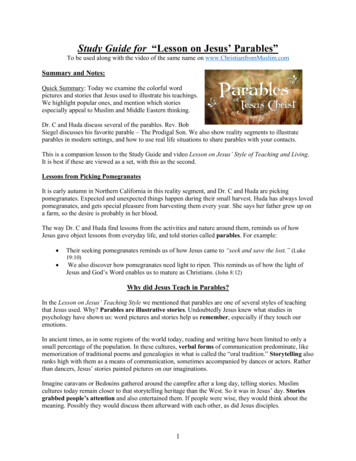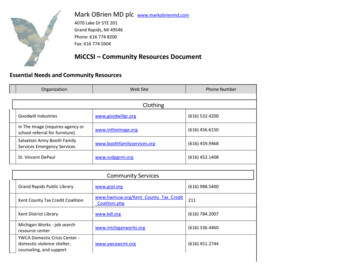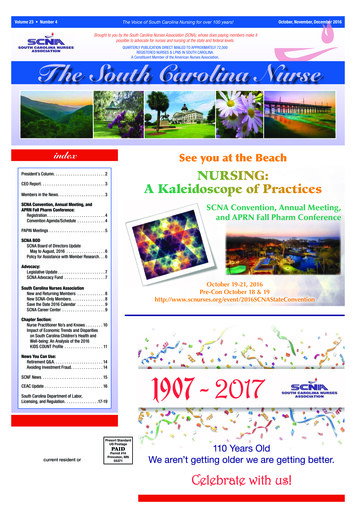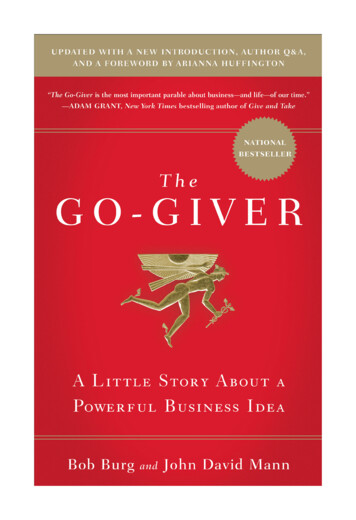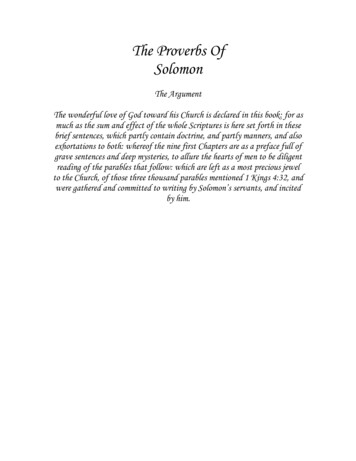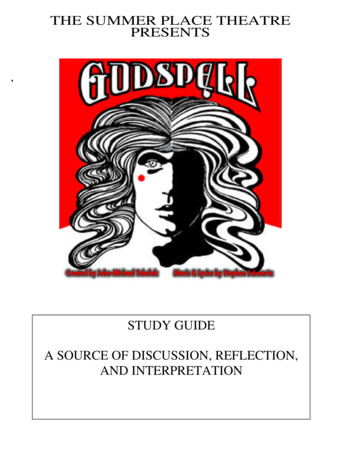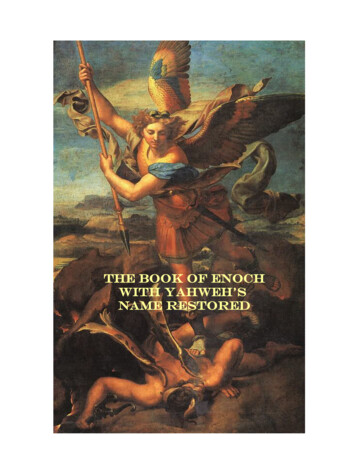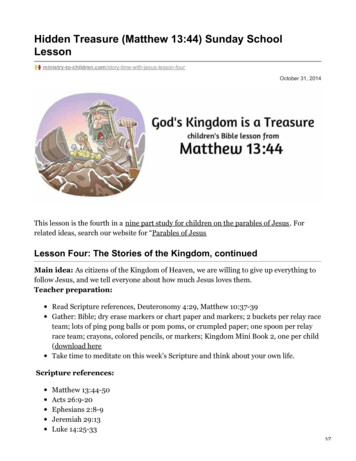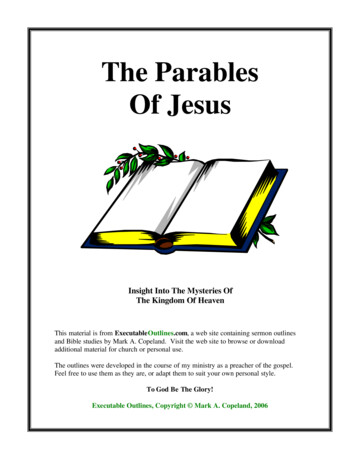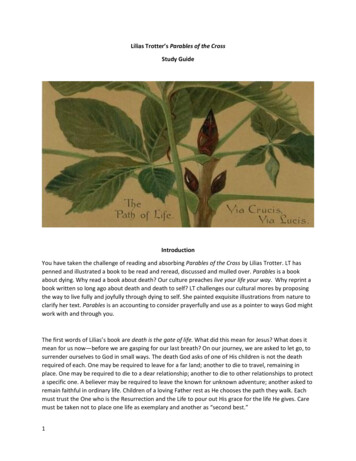
Transcription
Lilias Trotter’s Parables of the CrossStudy GuideIntroductionYou have taken the challenge of reading and absorbing Parables of the Cross by Lilias Trotter. LT haspenned and illustrated a book to be read and reread, discussed and mulled over. Parables is a bookabout dying. Why read a book about death? Our culture preaches live your life your way. Why reprint abook written so long ago about death and death to self? LT challenges our cultural mores by proposingthe way to live fully and joyfully through dying to self. She painted exquisite illustrations from nature toclarify her text. Parables is an accounting to consider prayerfully and use as a pointer to ways God mightwork with and through you.The first words of Lilias’s book are death is the gate of life. What did this mean for Jesus? What does itmean for us now—before we are gasping for our last breath? On our journey, we are asked to let go, tosurrender ourselves to God in small ways. The death God asks of one of His children is not the deathrequired of each. One may be required to leave for a far land; another to die to travel, remaining inplace. One may be required to die to a dear relationship; another to die to other relationships to protecta specific one. A believer may be required to leave the known for unknown adventure; another asked toremain faithful in ordinary life. Children of a loving Father rest as He chooses the path they walk. Eachmust trust the One who is the Resurrection and the Life to pour out His grace for the life He gives. Caremust be taken not to place one life as exemplary and another as “second best.”1
For LT, death is freeing us to live under the Holy Spirit’s control, filled with the love of God our Father.Death to self is ultimately about a heart free to worship Him. Who or what is first in my heart? Thatdetermines what I will worship and what will have control. LT challenges us as believers to recognize, bythe work of the Spirit, loves at the center of our hearts; to observe so that we can die to those loves andtheir control. We are then set free to worship God, the Father whose perfect love fills our hearts.Two more thoughts to consider: (1) The believer may find that a “dying” is not a one-time event.Something may have to be faced more than once. Also, the required sacrifice could be eventuallyreturned to the believer to hold as if in a trust—in a new and freer way. Elisabeth Elliot has describedthis dying as holding a gift with an “open hand” to be taken or allowed to remain. (2) Perhaps in everylife there will be a death of some kind. God led LT to die to her country, her family and friends, her art,and the life she knew. But had she remained in England, she would have died to a vocation ofinternational service, adventure, many new people to love, and a deep walk with her Savior. Finally, inher adopted country, her loving Father freed her to develop her art.This study guide provides the reader a short summary of the Parables of the Cross book text, Scriptureverses to read along with questions, page numbers of Parables for referencing, and further questions toexpand consideration of the text. We encourage readers not to skip what might be familiar Scriptureverses. Reading and considering them again will seal them in your heart.Note that the text of the Bible was so familiar to LT that she did not include references to the verses thatseem to flow into her writing. A list of verses, noted with page numbers, is included at the end of thestudy.2
Lesson 1: Death Is the Gate of Life(Parables of the Cross, pages 5–10)Section summary: Growing in knowledge of the blessing of God brings us to a crossroad. Life lived on itsown brings us to despair. Death is the “gate of life.” It is seen in the floral world of nature. It is evidencedand personalized in the death and resurrection of Christ. “He loved me and gave Himself for me,” asinner. As we begin to understand this redemptive work on our behalf, we grasp the importance ofdeath for life.Scripture reading: Genesis 3:1–15; Romans 5:5–8; Hebrews 2:14–18; Galatians 2:20What does Genesis 3 tell us went wrong in God’s perfect world? Consider Genesis 2:17 and 3:4 (“Youwill not surely die” NIV). What kind of death came because of Adam and Eve’s sin? To what death doesGenesis 3:15 point?What did Jesus accomplish by His death? Why did He die (Rom. 5:5–8)?Read Hebrews 2:14–18. Consider the reason Jesus had to die as fully human and fully God.Galatians 2:20 says that we are crucified with Christ. From that verse note the contrast between deathand life. How can we be crucified and yet live?What does life in Christ look like for you personally? (Write this down so you can compare it to yourresponses later in the study.)3
Parables of the Cross: Read pages 5–10 and consider the following: LT reminds us that death brings the thought of decay and dissolution and doom because of “thecurse.” What happened in Genesis 3 that brought a curse on humanity?Is there any release or freedom from that curse? What answer does LT provide as our onlyhope?LT states that the death of Christ is “death’s triumph hour” (p. 5). What did Christ win for us?How can His death lead us to triumphal deaths in our lives? (Remember that death is not a goodthing in itself but a “gate” to blessing.)LT notes that we come to the gate again and again, and that it is a deeper dying each time. Whatis this gate of dying? To what does it lead (p. 6)?Paraphrase LT’s example of the chestnut. What does this metaphor say to you personally?LT says, “Death is the only way out of the world of condemnation wherein we lie” (p. 9). How doGalatians 2:20 and Romans 5:5–8 express the hope that lies beyond condemnation? What hasGod poured out (Rom. 5:5) to lead us from death to life?As you begin this study of Parables of the Cross, take time to walk, sit outside, or enjoy a houseplant. Ask God to help you notice aspects of nature that illustrate the dying, living, andfruitfulness that LT describes. Her delight in God’s creation led her to delight in God Himself.For further consideration:John Piper, concerning Galatians 2:20:What Paul means is that there was an “I” who died, and there is a different “I” who lives. That iswhat it means to become a Christian . . . . . The new self is Christ living in me . . . I take this to mean the new self is defined byChrist’s presence and help at all times. —Fifty Reasons Why Jesus Came to DieGeorge MacDonald:The first thing in all progress is to leave something behind; to follow Him is to leave one’s selfbehind. —“Self-Denial” in Unspoken SermonsC. S. Lewis, in the essay “The Weight of Glory”:We are half-hearted creatures, fooling about with drink and sex and ambition when infinite joyis offered us, like an ignorant child who wants to go on making mud pies in a slum because hecannot imagine what is meant by the offer of a holiday at the sea. We are far too easily pleased.—The Weight of Glory and Other Addresses4
John Piper:Paul’s point is that life and death, for a Christian, are acts of worship—they exalt Christ andmagnify Him and reveal and express His greatness—when they come from an inner experienceof treasuring Christ as gain. Christ is praised in death by being prized above life. And Christ ismost glorified in life when we are most satisfied in Him even before death. —The DangerousDuty of DelightHymn reflection:In the Cross of Christ I GloryJohn BowringIn the cross of Christ I glory,towering o’er the wrecks of time;all the light of sacred storygathers round its head sublime.When the woes of life o’ertake me,hopes deceive and fears annoy,never shall the cross forsake me:Lo, it glows with peace and joy.5
Lesson 2: Death to Sin’s Penalty Is the Gate to a Life of Justification(Parables of the Cross, pages 10–15)Section summary: It is impossible for anyone to grow in the spiritual life apart from the cross of JesusChrist. God’s final goal for the believer is not mere safety, but holy living. If a believer relies on personalstriving, there will be a constant struggling with sin. There must be a barrier “between ourselves and theold nature” (p. 15). That barrier is found at the cross.Scripture reading: 1 Peter 3:18; Romans 3:23–26; Romans 6:1–14What did the death of Christ accomplish for the Christian?According to Romans 3:23–26, how is the believer justified? To clarify your thoughts, write a statementdefining justification as you understand it.How was our justification or freedom from the penalty of sin accomplished and by whom (Rom. 3:23–26)?Where do you struggle with recurring sin? What are some truths that we can access in our frustrationwith our sin? Begin listing those truths from Romans 6. Add to the list as you discover others.6
Parables of the Cross: Read pages 10–15 and consider the following: How does LT define justification? What does she say about any other way to find peace withGod?As you read through the book, consider LT’s definition of holiness (p. 11). Is it similar or differentfrom your own? What does Romans 8:28–30 describe as God’s goal for us?Have you at times sensed a dwindling or weakening in your life? What might be the cause? LTreminds us of the struggle from Romans 7:24: “Oh, wretched man that I am . . .”On page 12, how does LT bring the reader from the struggle of Romans 7 to the freedom ofRomans 8:1?How does the example of leaves on a plant expand her idea of “back to the Cross again”?Begin a personal spiritual timeline that shows deaths to self in your life journey. Add signs ofChrist’s new life growing in your life.For further consideration:Timothy Keller, on Romans 3:26:A wrathful God without grace will never give you the motivation to live a decent life. You willfeel crushed and despairing, or angry and defiant, and always be unloving, because fear can’tproduce love. If you have a God only made of standards and judgment, you will be a drivenperson, never able to live up to his standards, always fleeing from him.The wonder of the cross is that in the very same stroke it satisfies both the love of Godand the justice of God. At the very same moment it shows us that God is both the Judge, whocares enough about his world to set standards and hold us accountable to them; and theJustifier, who has done everything necessary to forgive and restore us. He is a Father worthhaving, and he is a Father we can have. —Romans 1–7 for YouRankin Wilbourne and Brian Gregor:The Gospel says that in Christ you have been completely and definitely accepted. You want to beholy—not so you can be accepted but because you have already been. You want to be holy soyou can experience more and more communion with God (1 John 2:6). You want to be holy—not so you will be loved but because you want to experience the love of God more and more.You want to experience God’s loving embrace. You want to know God more each day throughobeying him more each day.When the beauty of holiness and the joy of communion come together in your desire,the call to cruciform living becomes a call to holiness and happiness . . . Communion with God isthe joy set before us and our very great reward. —The Cross before Us7
Hymn reflection:What Wondrous Love Is ThisAmerican Folk HymnWhat wondrous love is this,O my soul, O my soul!What wondrous love is this, O my soul!What wondrous love is thisthat caused the Lord of blissto lay aside His crown for my soul, for my soul,to lay aside His crown for my soul.To God and to the Lamb,I will sing, I will sing.To God and to the Lamb, I will sing.To God and to the Lamb who is the great I AM,while millions join the theme,I will sing, I will sing.While millions join the theme I will sing.8
Lesson 3: Death to Sin Is the Gate to a Life of Holiness(Parables of the Cross, pages 15–31)Section summary: To grow in one’s life with Christ, sin must be shut off. This process depends on thedecisions of the believer and the ongoing work of God through His Spirit, reaching toward maturitythrough the process of sanctification. God can triumph even in the most difficult seasons of life.Becoming more like Christ through His death and resurrection is not solely for one’s personal benefit. Abeliever is called to spread the Good News among others. A self-centered focus results in barrenness.But a surrendered life brings “God-blessed treasure,” as in the life of Christ (see p. 31).Scripture reading: Colossians 3:1–12; John 16:7–15; Romans 8:5–11, 14–17In Colossians 3:1–10, what does Paul tell us to “seek” or “set”? And “put to death” (v. 5)? In verses 9–10,what are we to “put off” and “put on”? In verse 12a, how does remembering who we are help us in thetask of dying to sin? Prayerfully envision what a life of holiness would look like for you. What specificattitudes or actions (possibly in regard to specific people) would you discard or put on?In John 16:7–15, what does Jesus say about the work of the Holy Spirit? What will the Holy Spirit do forus to lead us to holiness?According to Romans 8:5–17, what glorious truths will empower us to continue our growth towardChristlikeness?9
Parables of the Cross: Read pages 15–31 and consider the following: What do you think LT means by “ego” on page 15?LT outlines two ways, or two parts, to dying to sin. What are they (p. 16)? What light doesRomans 5:5 shed on this process?Is dying to sin a gradual process? Consider the LT’s comments on pages 16 and 25. Do youagree? How is her example of the flowering rush helpful (pp. 20–25)?Are sins of the old life the same for every believer? How do we respond when someone hasgiven up something that we have not?How does LT define holiness or sanctification? What is the starting point (p. 20)? Consider LT’scomments on page 20 along with the passage from Romans 8. Who is responsible for oursanctification?In what way is our Christian identity shaped by the process of our sanctification? How doesfocusing on the glory of the Father and all He has accomplished for us help us establish thatidentity? “What more do we need for our souls than to have this God for our God” (p. 25)?LT uses the example of the gorse bush to encourage the believer when no change is visible (p.26). She quotes Hebrews 12:11 and then says, “Take the very hardest thing in your life . . . andexpect God to triumph gloriously in that very spot” (p. 29). Consider the illustration on page 27.How does it speak to you: set in pain comes “the jewel of His joy”? Journal or discuss a situationin which you can expect God to triumph gloriously.Perhaps you have turned from sin but do not experience the joy and peace of the Holy Spirit.Return to Romans 8:14–17. What encouragement does Paul provide?What is the danger of focusing on growth only for ourselves (p. 29)? Where have you seen Godleading you out to service of others? Where do you see God leading you now? How does theexample of the opal expand the idea (p. 30)? What does LT mean by “an utter yielding of ourbest” (p. 31)?For further consideration:Saint Augustine of Hippo, describing his dramatic conversion from a life of reckless sin and disorderedloves:How sweet all at once it was for me to be rid of those fruitless joys which I had once feared tolose? . . . You drove them from me, you who are the true, the sovereign joy. You drive themfrom me and took their place, you who are sweeter than all pleasure.Rebecca Pippert:Whatever controls us is our lord. The person who seeks power is controlled by power. Theperson who seeks acceptance is controlled by the people he or she wants to please. We do notcontrol ourselves. We are controlled by the lord of our lives. —Out of the Salt Shaker & into theWorld10
This prayer by Evelyn Bence relates to LT’s text on page 20:Brother Lawrence gave his life to You on a bleak winter day. With his eyes he saw an ordinarytree, wind stripped of leaves, stark, gaunt, heavy with the look of death. But in his mind he sawthe same tree in summer, plush, rich with green, which clung to its branches, which hid a villageof birds. If such transformation was a sample of Your work, he wanted the same for himself. Youheard his prayer, Lord. With his permission, You watered him, warmed him, bathed him in Yourpresence until he budded into life. Now, three centuries later, my request must sound familiarto you: I see a tree in winter and I know Your power hasn’t diminished. —The PromisePrayer by Saint Catherine of Siena:Clothe me, clothe me with yourself.Hymn reflection:I Surrender AllJ. W. Van DeventerAll to Jesus I surrender,all to Him I freely give;I will ever love and trust Him,in His presence daily live.All to Jesus I surrender,humbly at His feet I bow,worldly pleasures all forsaken,take me, Jesus, take me now.All to Jesus I surrender,Lord, I give myself to Thee;fill me with Thy love and power,let Thy blessing fall on me.11
Lesson 4: Death to Lawful Things Is the Gate to a Life of Surrender(Parables of the Cross, pages 32–43)Section summary: God may ask us to “loosen” our grasp on people, places, or things that are goodthings, “lawful things.” God asks believers to die to self in varying ways, while holding everything loosely.Dying even to lawful things liberates new power in the believer. The dying will go deeper as life goes on.One result will be greater love for all people.Scripture reading: Matthew 16:24–26; Philippians 2:1–11, 15; Philippians 3:7–11; 2 Corinthians 8:9; 2Corinthians 4:7–12, 16–18; 1 John 3:16In Matthew 16:24–26, Jesus brings us, as LT says, “back to the cross.” What do these verses teach aboutdying/living, grasping/releasing? What does the believer gain?According to Philippians 2, what is the heart attitude we need? How is it like Christ? In verses 9–11, whatis the final glory? In verse 15, we are shone the end result.Note in Philippians 3:7–11 the progression of gain, loss, gain. What is the believer’s final gain?In 2 Corinthians 8:9, Paul explains the grace of Jesus in another way. How does Paul explain what Christhas done for you? How does this apply to your life?12
Death seems to be a constant for the Christian. As explained in 2 Corinthians 4:7–12, what do believerscarry in their bodies? How can this be a grace for us? According to verses 16–18, how can we not loseheart? How is the “eternal weight of glory” (King James Version) an anchor for your life?First John 3:16 pictures of how Jesus’s death is evidenced in the believer’s life and how it affects others.What evidence of this transformation do you see unfolding in your life?Parables of the Cross: Read pages 32–43 and consider the following: LT begins this section with the lesson of the buttercup. Paraphrase that lesson in your ownwords. Why would God ask us to be “hands off” of the treasures He has given? Do you live in anarea where buttercups grow wild? What do you notice about the buttercup?Have you struggled with “partial relaxing of grasp” (p. 32)? Is it realistic to think that you cansettle something in your heart completely all at once? Compare this with the idea of giving toJesus what you know right now, knowing that He will ask more if need be.In your life, who chooses what you will hold loosely? Do we hold all in life loosely? What do youthink are the heart results of that kind of holding?LT says letting go is simply yielding (p. 35). To whom do we yield these things? How can thatcomfort and encourage your heart? How does the ”gain” of Philippians 3:7–11 fill to overflowingthe heart space created by yielded things? How can this heart space make room not only forGod’s presence, but also for the needs of others?Has God ever asked you to yield over something that He later returned to you? Describe thattime and its significance for/in your faith journey.LT encourages the believer to enjoy “His April days” while you have them. It is important toremember in the midst of lessons on dying that “every stage of the heavenly growth in us islovely to Him; He is the God of the daisies and the lambs and the merry child hearts!” (p. 36).How and when have you seen April days mixed in with days of dying?List—and savor—some of the rewards of dying (p. 39). LT writes, “It is loss to keep when Godsays ‘give.’”How does LT tell us we can experience freedom (pp. 39–40)?On page 43, we learn that “deeper and deeper must be the dying, for wider and fuller is thelifetide that it is to liberate.” What is LT teaching us? Have you seen this in your life? What is thegrace that leads us?LT writes about dying to all that is “merely human” (p. 43). Is anything in life merely human?What can she mean by this?How has dying to self produced fruitfulness in your life? What signs of Christ’s life do you seegrowing in you?For further consideration:Jesse Penn-Lewis, an acquaintance of Lilias—in relation to Philippians 2:He, as God, deliberately laid aside His position and power.He deliberately took the form of a servant.13
He deliberately took the place of weakness.He, as a man, deliberately humbled Himself.He deliberately carried out an obedience even unto death.He deliberately went to the cross.“Let this mind be in you which was in Christ Jesus” . . .Finally . . . We shall see the cross from God’s standpoint and glory in it. The joy set before us, thejoy unspeakable and full of glory, shall even now break forth, as with unveiled face beholding theglory of the Lord, we are changed into the same image, from glory to glory, by the Spirit of the Lord.“Wherefore we faint not!” “For our light affliction, which is for the moment works for us . . . [an]eternal weight of glory" (2 Cor. 4:16–17). —The Message of the CrossElisabeth Elliot:Open hands should characterize the soul’s attitude toward God—open to receive what He wantsto give, open to give back what He wants to take. Acceptance of the will of God meansrelinquishment of our own [will and plans]. —A Path through SufferingSaint Augustine of Hippo:But living a just and holy life requires one to be capable of an objective and impartial evaluationof things: to love things, that is to say, in the right order, so that you do not love what is not tobe loved, or fail to love what is to be loved, or have a greater love for what should be loved less,or an equal love for things that should be loved less or more, or a lesser or greater love forthings that should be loved equally. —On Christian Doctrine 1.27–28.Hymn reflection:Jesus, Plant and Root in MeCharles WesleyJesus, plant and root in meall the mind that was in Thee;Settled peace I then shall find;Jesus is a quiet mind.We Give Thee but Thine OwnWilliam W. HowWe give thee but Thine own,whate’er the gift may be:all that we have is Thine alone,a trust, O Lord, from Thee.14
May we Thy bounties thusas stewards true receive,and gladly, as Thou blessest usto Thee our first fruits give.To comfort and to bless,to find a balm for woe,to tend the lone and fatherlessis angels’ work below.And we believe Thy word,though dim our faith may be:whate’er for Thine we do, O Lord,we do it unto Thee.15
Lesson 5: Death to Self Is the Gate to a Life of Sacrifice: Part 1(Parables of the Cross, pages 44–59)Section summary: The death of the self-life is not hindered merely by selfishness. The death of the selflife is more subtle and may look like sacrifice. Overcoming the self-life is not accomplished by strugglingor wrestling but by dying to it in Jesus. The gladness of the resurrection results in power set free tomultiply new life. Although dying may look different for each believer, sacrifice will overflow in service.Scripture reading: Romans 12:1; Philippians 2:12–13; 1 Peter 2:4–12; 1 Peter 1:22; John 5:30; 6:38 In Romans 12:1, Paul notes what spurs us on to sacrifice. How does God’s great mercy enable usto offer ourselves as a sacrifice? What does Paul call that sacrifice? How is sacrifice worship?What does Philippians 2:12–13 say about who is responsible for our growth in Christ?What is meant by “spiritual sacrifices” in 1 Peter 2:5? List the truths of 1 Peter 2:9–10. How dothey encourage us in making “spiritual sacrifices”?According to 1 Peter 1:22, what is the result of an obedient walk with Christ?What does Jesus say about Himself in John 5:30 and 6:38? How should that instruct us? How doyou respond when you realize that even Jesus laid down His own will?Parables of the Cross: Read pages 44–59 and consider the following: 16LT uses the examples and images of the dandelion, wild iris pods, and oat grass to explore thetruths of sacrifice. How are these examples helpful to you?
The above examples do not hold on to their petals or pods but give freely. In contrast, LT saysthat believers often do not let go because of “mere selfishness” (p. 47). What are some subtlereasons why what looks like sacrifice may not be what it seems? (See p. 47 for LT’s list.) Arethere others?LT calls this deeper surrender to the self-life the “last surrender” (p. 47). What do you think thismeans?LT says (p. 48) that it is not by struggling and wrestling that we lay down the self-life but bydying to it in Jesus. Can even that dying be a work that I try to do myself? Does LT get at theheart of what strengthens the believer to give all to Jesus? A paragraph from her book TheSevenfold Secret may be helpful:Again, as the bread satisfies the hunger of the body, so this indwelling of Christ in ussatisfies the hunger of the soul, until it becomes rested through and through. And webelieve that this hunger of the soul has been granted to you . . . by the Grace of God, toprepare you for the satisfying that is to be found in our Lord the Christ according tothese His words: “He that cometh to me shall never hunger, and he that believeth in meshall never thirst.” (p. 15) How does the deep love of God the Father—shown in the death and resurrection of Jesus Christand the filling of our hearts by the Holy Spirit—enable us to release completely our hearts andlives to Him?LT gives new meaning to 2 Timothy 2:12. On page 54, what does “reigning with Him” mean?What can it look like in your life? Can you see ways that your life brings glory to Jesus? If not, tryconsider asking for input from a trusted friend.On pages 54 and 57, LT testifies to the riches of this life that is surrendered to Jesus. Which ofthose are especially important for you?How can it be helpful (p. 59) to remember that we are not responsible for “the tangible resultsof our ministry to others”? What does a ministry that demonstrates the Spirit look like? Wherehave you seen or experienced this?For further consideration:Rankin Wilbourne and Brian Gregor quote Nietzsche as writing:Nietzsche, who is the actual originator of the phrase ”long obedience in the same direction,”writes of the importance of the thousand tiny decisions that make up our days: ”The littlevegetation that grows in between everything and understands how to cling everywhere, this iswhat ruins what is great in us—the quotidian, hourly pitifulness of our environment that goesoverlooked, the thousand tiny tendrils of this or that small and small-minded feeling growingout of our neighborhood, our job, the company we keep, the division of our day. If we allowthese small weeds to grow unwittingly, then unwittingly they will destroy us!” —The Crossbefore Us17
C. S. Lewis:About the past, and nothing being lost, the point is that “He who loses his life shall save it” istotally true, true on every level. Everything we crucify will rise again; nothing we try to hold ontowill be left us. —C. S. Lewis Collected Letters [letter to Dom Bede Griffiths, May 25, 1944]John Wesley:If we do not continually deny ourselves, we do not learn of Him, but of other masters . . . If weare not walking in the way of the cross, we are not following Him; we are not treading in Hissteps; but going back from, or at least wide of, Him. —“On Self-Denial”Hymn reflection:Take My Life and Let It BeFrances Ridley HavergalTake my life and let it beconsecrated, Lord, to Thee.Take my moments and my days,let them flow in ceaseless praise.Take my hands, and let them moveat the impulse of thy love.Take my lips and let them befilled with messages from Thee.Take my silver and my gold;not a mite would I withhold.Take my intellect and useevery power as Thou shalt chose.Take my love, my Lord, I pourat Thy feet its treasure store.Take myself, and I will beever, only all for Thee.18
Lesson 6: Death to Self Is the Gate to a Life of Sacrifice: Part 2(Parables of the Cross, pages 59–64)Section summary: Life leads on to a new death, which then brings new life: “God’s Divine spiral” (p. 60).The lesson from sphagnum is that death is crowned with new life. In LT’s Parables of the Cross, deathhas been emphasized, but life is uppermost. Death is a gateway to life, so we should not be filled withgloom. Our works will remain after us if Jesus tarries. What are the endless possibilities of what God willdo? Surrender and sacrifice, which lead us back to the cross of Jesus, can be seen in nature and testedagain and again in the life of the believer.Scripture reading: Romans 6:8–14; Philippians 1:20–24; Galatians 2:20; Luke 20:38; 2 Corinthians 9:6–10; Psalm 37:4–6 19Back to Romans 6:8–14 again. With whom have we died? Because He lives, how should we viewdeath? On page 60, LT says that death is a gateway and “is never a dwelling-place; the deathstage is never meant for our souls to stay and brood over, but to pass through with a will intothe light beyond.”How does Paul face the tension of Philippians 1:20–24 with living for Christ as in Galatians 2:20?Write a statement now about your understanding of death and life for the Christian. How mightthis tension be lived out in your life? Are there places where God has asked you to continue todie? Are there areas He has given the relinquished gift back to you again, perhaps in a differentway? If you are familiar with details of LT’s biography, you might consider examples in her life.
What does Luke 20:38 say about the character of God? How does God’s “glory of His gladness”shining out affect your view of life (p. 63)?Wha
This study guide provides the reader a short summary of the Parables of the Cross book text, Scripture verses to read along with questions, page numbers of Parables for referencing, and further questions to expand consideration of the text. We encourage rea
